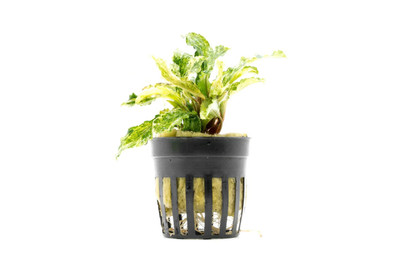Bucephalandra Marble Variegated
Posted by Max Gandara on on 18th Oct 2024
Bucephalandra Marble Variegated: A Stunning Addition to Aquascapes
Bucephalandra Marble Variegated, often referred to simply as Bucephalandra, is a striking aquatic plant known for its unique leaf patterns and colors. As a popular choice among aquascapers and plant enthusiasts, this plant brings a touch of elegance and diversity to any aquarium. In this blog, we will explore its origins, care requirements, and best uses in aquascaping.
Latin Name and Place of Origin
The scientific name for this plant is Bucephalandra sp., and it is native to Borneo, Indonesia, specifically found in the rivers and streams of this tropical island. This plant thrives in the submerged conditions of its natural habitat, often growing on rocks and driftwood in shaded areas, which informs its care requirements in aquariums.
Appearance and Growth
Bucephalandra Marble Variegated features thick, glossy leaves that can vary in color from deep green to rich marbled shades of cream and white. The unique variegation patterns make each plant visually striking, adding texture and interest to aquascapes.
- Height: Typically grows to about 4-8 inches (10-20 cm)
- Leaf Shape: Oblong and thick, with prominent venation
- Color: Variegated leaves with shades of green, cream, and white
This plant's compact growth habit makes it an excellent choice for various placement options within the aquarium.
Ideal Conditions for Bucephalandra Marble Variegated
Bucephalandra Marble Variegated is relatively easy to care for but thrives under specific conditions. Here are the key requirements to ensure healthy growth:
1. Lighting
This plant prefers low to moderate lighting. Bright light can lead to leaf burn, while too little light may hinder growth.
- Lighting intensity: Low to moderate (PAR 30-50)
- Duration: 6-10 hours daily
Providing a balance of light is crucial for maintaining the plant’s vibrant colors and healthy growth.
2. CO2 and Nutrients
Bucephalandra can grow well without CO2 supplementation, but providing CO2 can enhance growth and color vibrancy, especially in high-tech setups. Fertilization with liquid fertilizers is also beneficial.
- CO2: Not necessary but beneficial
- Fertilization: Regular liquid fertilization or nutrient-rich substrate is recommended.
3. Water Parameters
Bucephalandra Marble Variegated is adaptable to a range of water conditions, making it suitable for most freshwater aquariums. However, ideal water parameters include:
- Temperature: 72-82°F (22-28°C)
- pH: 6.0-7.5
- Water hardness: Soft to moderately hard
Maintaining stable water conditions is essential for the plant's health.
4. Substrate
This plant can thrive in a variety of substrates, including gravel, sand, or nutrient-rich soil. However, it is best to anchor it to rocks or driftwood, allowing the roots to establish while promoting a natural look.
Propagation
Bucephalandra Marble Variegated can be propagated through division. This involves separating established plants into smaller sections, ensuring each section has roots and leaves for successful growth.
- Propagation method: Gently separate the rhizome and replant the sections in the desired location.
Best Use in Aquascaping
Bucephalandra Marble Variegated is an incredibly versatile plant that can enhance various aquascaping styles. Here are some of the best uses for this stunning plant:
1. Midground Plant
Due to its compact growth habit, Bucephalandra makes an excellent midground plant. It provides a lush green backdrop for taller background plants while adding a pop of color with its variegated leaves.
2. Accent Plant
This plant can also be used as an accent plant, strategically placed among rocks and driftwood to create focal points within the aquascape. Its unique leaf patterns will draw the eye and add visual interest.
3. Natural Habitat for Fish
Bucephalandra Marble Variegated provides shelter and hiding spots for smaller fish and invertebrates, promoting a more natural environment. The dense foliage creates a safe haven for shy species, enhancing their well-being.
Common Challenges and Troubleshooting
While Bucephalandra Marble Variegated is generally easy to care for, some common issues may arise:
- Yellowing Leaves: If the leaves begin to yellow, it may indicate nutrient deficiencies or insufficient light. Adjusting light levels or adding fertilizers can help resolve this issue.
- Algae Growth: In lower light conditions, Bucephalandra may compete poorly against algae. Maintaining proper lighting, water quality, and regular maintenance can help mitigate this problem.
- Slow Growth: If the plant isn’t growing as expected, check for adequate light, nutrients, and CO2 levels. Increasing light intensity or providing additional nutrients may help promote growth.
Conclusion
Bucephalandra Marble Variegated is a stunning and versatile aquatic plant that can elevate the beauty of any freshwater aquarium or aquascape. Its unique leaf patterns, adaptability, and low maintenance make it a favorite among hobbyists. Whether used as a midground feature or an accent plant, Bucephalandra Marble Variegated will add elegance and charm to your underwater landscape.
With proper care and attention, this beautiful plant can thrive and contribute to a vibrant aquarium environment, making it a cherished addition to any aquascape.

